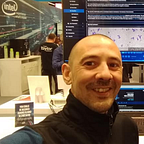Medical Facial Recognition Security Systems With Intel® Movidius™ NCSDK/Intel® OpenVINO™ Toolkit & Intel® Movidius™ Neural Compute Stick 1 & 2
Introduction
Security is an important issue for hospitals and medical centers to consider. Today’s Facial Recognition can provide ways of automating security in the medical industry, reducing staffing costs and making medical facilities safer for both patients and staff.
The Facial Recognition Security Systems projects provided in the HIAS GeniSysAI repository are based on the GeniSysAI Vision projects. The systems are IoT connected via the HIAS local iotJumpWay broker allowing device to device communication that can provide automated responses to identified users or intruders.
Hardware
HIAS GeniSysAI devices are designed to be used on popular low powered, IoT devices such as Raspberry Pi and Aaeon’s UP2 (Up Squared). This makes them easy to use and affordable.
Raspberry Pi
Raspberry Pi by the Raspberry Pi Foundation are the most popular of the available mini ARM computers. RPIs provide easily affordable single board computers that have been widely adopted by the IoT and AI communities. The HIAS GeniSysAI projects suppory Raspberry Pi 3 and 4.
UP2 (UP Squared)
UP2 by Aaeon are also popular with the IoT and AI communities. Unlike the Raspberry Pi, the UP2 have Intel Pentium quad-core processors. The UP2 are bigger than the Raspberry Pi, but are also more expensive.
Vision Hardware
We use Intel® hardware to maximize performance of the HIAS GeniSysAI Facial Recognition Security Systems. You can find out more about these hardwares in this section.
Intel® Movidius™ Neural Compute Stick
The Intel® Movidius™ Neural Compute Stick is a USB plug & play AI device for deep learning inference at the edge. The Intel® Movidius™ Neural Compute Stick is built on the Intel® Movidius™ Myriad™ 2 VPU which features 12 programmable shave cores for vision neural network acceleration.
Intel® Movidius™ Neural Compute Stick 2
The Intel® Movidius™ Neural Compute Stick 2 is a USB plug & play AI device for deep learning inference at the edge. Combined with the Intel® OpenVINO™ Toolkit, developers can develop, fine-tune, and deploy convolutional neural networks (CNNs) on low-power applications that require real-time inference.
Vision Software
We use Intel® SKDs and Toolkits to maximize performance of the HIAS GeniSysAI Facial Recognition Security Systems. You can find out more about these softwares in this section.
Intel® Movidius™ NCSDK
For the oldskool Neural Compute Stick developers, we have revived the original GeniSysAI NCSDK projects. NCSDK was the first Intel SDK for the Neural Compute Stick 1 and provided the software for converting models created with a range of AI frameworks into graphs that are compatible with the NCS1.
Intel® OpenVINO™ Toolkit
The Intel® OpenVINO™ Toolkit is Intel’s latest contribution to computer vision developers. The toolkit is based on Convolutional Neural Network and optimizes models used on Intel CPUs/GPUs, VPUs, FPGA etc. Models are converted to Intermediate Representations (IR) which allow them to be used with the Inference Engine.
Vision Projects
Below you will find details of the Facial Recognition Security System projects provided in this repository.
UP2 Vision Projects
The UP2 NCS1 Facial API Security System hosts API endpoints exposing a Facenet classifier for remote Facial Recognition requests.
The UP2 NCS1 Foscam Security System connects to a Foscam IP camera and uses a Facenet classifier to provide Facial Recognition.
The UP2 NCS1 USB Camera Security System connects to a USB camera and uses a Facenet classifier to provide Facial Recognition.
The UP2 OpenVINO USB Camera Security System connects to a Foscam IP camera and uses facial detection/facial reidentification and facial landmark classifiers to provide Facial Recognition on CPU or VPU (Neural Compute Stick 1 & 2).
The UP2 OpenVINO USB Camera Security System connects to a USB camera and uses facial detection/facial reidentification and facial landmark classifiers to provide Facial Recognition on CPU or VPU (Neural Compute Stick 1 & 2).
Contributing
Asociacion De Investigacion En Inteligencia Artificial Para La Leucemia Peter Moss encourages and welcomes code contributions, bug fixes and enhancements from the Github community.
Please read the CONTRIBUTING document for a full guide to forking our repositories and submitting your pull requests. You will also find information about our code of conduct on this page.
Versioning
We use SemVer for versioning. For the versions available, see Releases.
License
This project is licensed under the MIT License — see the LICENSE file for details.
Bugs/Issues
We use the repo issues to track bugs and general requests related to using this project. See CONTRIBUTING for more info on how to submit bugs, feature requests and proposals.
Originally published at https://github.com.
